How to install MySQL 8.0 in Ubuntu 18.04
MySQL Community Server is a free, open source, popular, cross-platform database management system. It supports both SQL and NoSQL and has a pluggable storage engine architecture. Additionally, it provides multiple database connectors for different programming languages, allowing you to develop applications using any known language and many other features.

It has many use cases in areas such as document storage, cloud computing, high availability systems, IoT, hadoop, big data, data warehouses, LAMP or LEMP stacks, etc. for Support large-capacity websites/applications, etc.
Recommended reference study: "mysql tutorial"http://www.php.cn/course/list/51.html
In this article, we will explain the fresh installation of MySQL 8.0 database system on Ubuntu 18.04 Bionic Beaver.
Step 1: Add MySQL Apt Repository
There is an APT repository for installing MySQL server, client and other components. You need to add this MySQL repository to your system's list of package sources; first download the repository package using the wget tool from the command line.
$ wget -c https://dev.mysql.com/get/mysql-apt-config_0.8.10-1_all.deb
Then use the following dpkg command to install the MySQL repository package.
$ sudo dpkg -i mysql-apt-config_0.8.10-1_all.deb
Please note that during the package installation process, you will be prompted to select the MySQL server version and other components such as clustering, shared client libraries, or MySQL workbench to configure for installation.
mysql-8.0 will automatically select the MySQL server version, then scroll down to the last option Ok and click [Enter] to complete the configuration and installation of the release package as shown in the screenshot.

Step 2: Install MySQL Server in Ubuntu 18.04
Next, download the Recently added MySQL repositories) download the latest package information.
$ sudo apt update
Then run the following commands to install packages for MySQL community server, client and database common files.
$ sudo apt-get install mysql-server
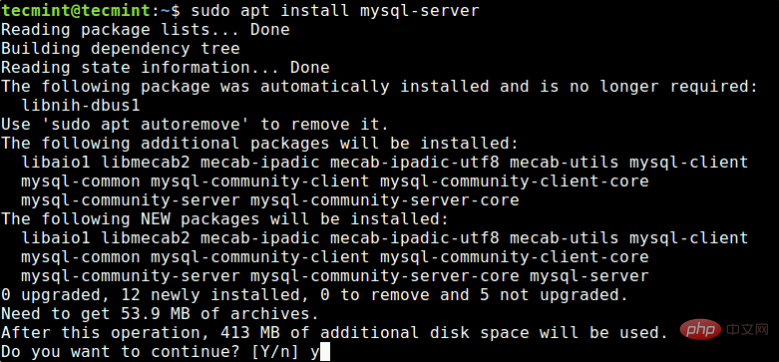
Through the installation process, you will be asked to enter the password for the root user of your MySQL server, please re-enter the password to confirm and press [Enter].
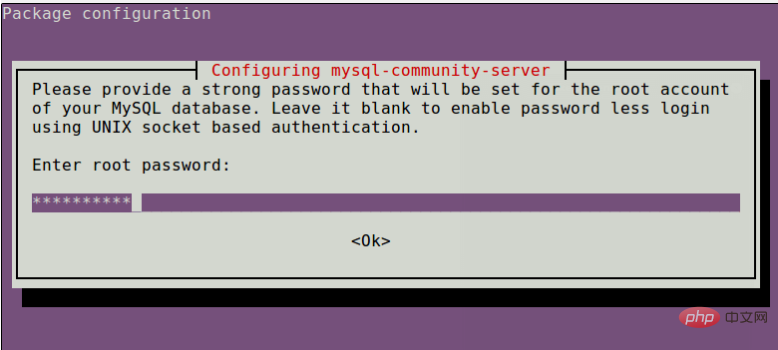
Next, the MySQL Server Authentication Plugin Configuration message will be displayed, read through it and use the right arrow to select Ok and press [Enter] to continue.
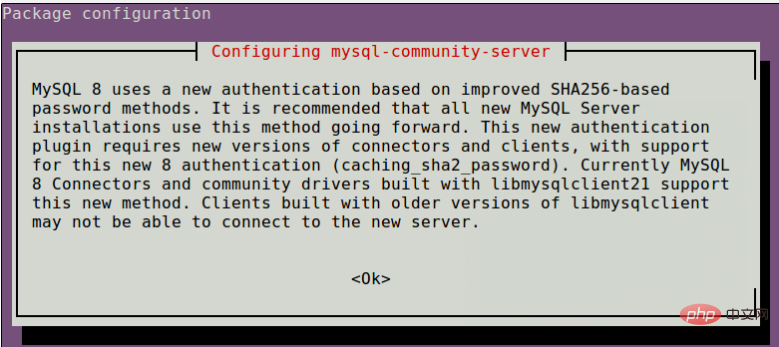
You will then be asked to select the default authentication plugin to use, then use the right arrow to select Ok and press [Enter] to complete the package configuration.

Step 3: Securing MySQL Server Installation
By default, MySQL installation is not secure. To secure it, run the security script included with the binary package. You will be asked to enter the root password you set during installation. Then also choose whether to use the VALIDATE PASSWORD plug-in.
You can also change the root password you set previously (as we did in this example). Then enter yes/y the following security question:
Delete anonymous user? (Press y | Y for yes, any other key for no): y
Remote login prohibited? (Press y|Y for yes, any other key for no):y
Delete the test database and access it? (Press y|Y for yes, any other key for no): y
Now reload the permissions table? (Press y|Y for yes, any other key for no):y
Start the script by issuing the following command.
$ sudo mysql_secure_installation
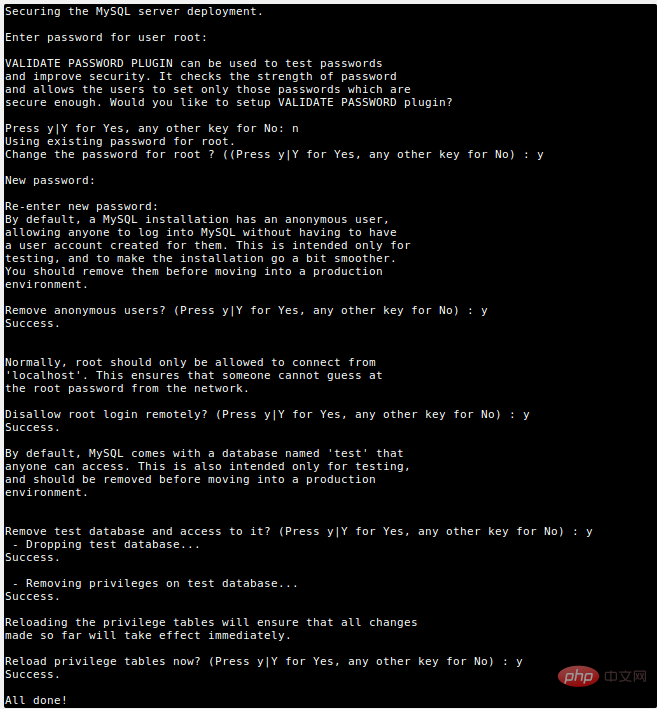
Step 4: Manage MySQL Server via Systemd
On Ubuntu, after installing the package, once the package is configured , its service will usually start automatically. You can check if the MySQL server is up and running using the following command.
$ sudo systemctl status mysql
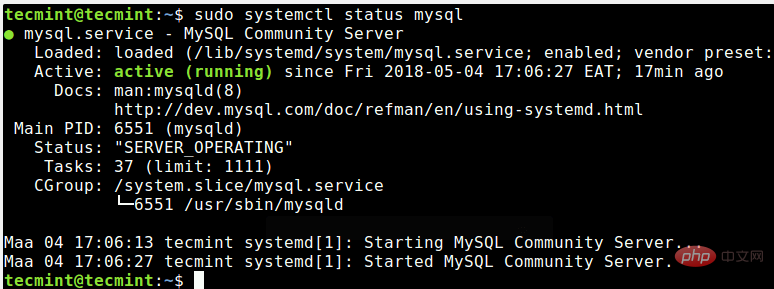
If for some reason, it does not start automatically, use the following command to start it and enable it to start on system startup as shown below.
$ sudo systemctl status mysql $ sudo systemctl enable mysql
第5步:安装额外的MySQL产品和组件
此外,您可以安装额外的MySQL组件,以便与服务器一起使用,例如mysql-workbench-community,libmysqlclient18和许多其他组件。
$ sudo apt-get update $ sudo apt-get install mysql-workbench-community libmysqlclient18
最后,要访问MySQL shell,请发出以下命令。
$ sudo mysql -u root -p

本篇文章就是关于在Ubuntu 18.04中安装MySQL 8.0的安装步骤介绍,希望对需要的朋友有所帮助!
The above is the detailed content of How to install MySQL 8.0 in Ubuntu 18.04. For more information, please follow other related articles on the PHP Chinese website!

Hot AI Tools

Undresser.AI Undress
AI-powered app for creating realistic nude photos

AI Clothes Remover
Online AI tool for removing clothes from photos.

Undress AI Tool
Undress images for free

Clothoff.io
AI clothes remover

Video Face Swap
Swap faces in any video effortlessly with our completely free AI face swap tool!

Hot Article

Hot Tools

Notepad++7.3.1
Easy-to-use and free code editor

SublimeText3 Chinese version
Chinese version, very easy to use

Zend Studio 13.0.1
Powerful PHP integrated development environment

Dreamweaver CS6
Visual web development tools

SublimeText3 Mac version
God-level code editing software (SublimeText3)

Hot Topics
 When might a full table scan be faster than using an index in MySQL?
Apr 09, 2025 am 12:05 AM
When might a full table scan be faster than using an index in MySQL?
Apr 09, 2025 am 12:05 AM
Full table scanning may be faster in MySQL than using indexes. Specific cases include: 1) the data volume is small; 2) when the query returns a large amount of data; 3) when the index column is not highly selective; 4) when the complex query. By analyzing query plans, optimizing indexes, avoiding over-index and regularly maintaining tables, you can make the best choices in practical applications.
 Can I install mysql on Windows 7
Apr 08, 2025 pm 03:21 PM
Can I install mysql on Windows 7
Apr 08, 2025 pm 03:21 PM
Yes, MySQL can be installed on Windows 7, and although Microsoft has stopped supporting Windows 7, MySQL is still compatible with it. However, the following points should be noted during the installation process: Download the MySQL installer for Windows. Select the appropriate version of MySQL (community or enterprise). Select the appropriate installation directory and character set during the installation process. Set the root user password and keep it properly. Connect to the database for testing. Note the compatibility and security issues on Windows 7, and it is recommended to upgrade to a supported operating system.
 Explain InnoDB Full-Text Search capabilities.
Apr 02, 2025 pm 06:09 PM
Explain InnoDB Full-Text Search capabilities.
Apr 02, 2025 pm 06:09 PM
InnoDB's full-text search capabilities are very powerful, which can significantly improve database query efficiency and ability to process large amounts of text data. 1) InnoDB implements full-text search through inverted indexing, supporting basic and advanced search queries. 2) Use MATCH and AGAINST keywords to search, support Boolean mode and phrase search. 3) Optimization methods include using word segmentation technology, periodic rebuilding of indexes and adjusting cache size to improve performance and accuracy.
 Difference between clustered index and non-clustered index (secondary index) in InnoDB.
Apr 02, 2025 pm 06:25 PM
Difference between clustered index and non-clustered index (secondary index) in InnoDB.
Apr 02, 2025 pm 06:25 PM
The difference between clustered index and non-clustered index is: 1. Clustered index stores data rows in the index structure, which is suitable for querying by primary key and range. 2. The non-clustered index stores index key values and pointers to data rows, and is suitable for non-primary key column queries.
 MySQL: Simple Concepts for Easy Learning
Apr 10, 2025 am 09:29 AM
MySQL: Simple Concepts for Easy Learning
Apr 10, 2025 am 09:29 AM
MySQL is an open source relational database management system. 1) Create database and tables: Use the CREATEDATABASE and CREATETABLE commands. 2) Basic operations: INSERT, UPDATE, DELETE and SELECT. 3) Advanced operations: JOIN, subquery and transaction processing. 4) Debugging skills: Check syntax, data type and permissions. 5) Optimization suggestions: Use indexes, avoid SELECT* and use transactions.
 Explain different types of MySQL indexes (B-Tree, Hash, Full-text, Spatial).
Apr 02, 2025 pm 07:05 PM
Explain different types of MySQL indexes (B-Tree, Hash, Full-text, Spatial).
Apr 02, 2025 pm 07:05 PM
MySQL supports four index types: B-Tree, Hash, Full-text, and Spatial. 1.B-Tree index is suitable for equal value search, range query and sorting. 2. Hash index is suitable for equal value searches, but does not support range query and sorting. 3. Full-text index is used for full-text search and is suitable for processing large amounts of text data. 4. Spatial index is used for geospatial data query and is suitable for GIS applications.
 The relationship between mysql user and database
Apr 08, 2025 pm 07:15 PM
The relationship between mysql user and database
Apr 08, 2025 pm 07:15 PM
In MySQL database, the relationship between the user and the database is defined by permissions and tables. The user has a username and password to access the database. Permissions are granted through the GRANT command, while the table is created by the CREATE TABLE command. To establish a relationship between a user and a database, you need to create a database, create a user, and then grant permissions.
 Can mysql and mariadb coexist
Apr 08, 2025 pm 02:27 PM
Can mysql and mariadb coexist
Apr 08, 2025 pm 02:27 PM
MySQL and MariaDB can coexist, but need to be configured with caution. The key is to allocate different port numbers and data directories to each database, and adjust parameters such as memory allocation and cache size. Connection pooling, application configuration, and version differences also need to be considered and need to be carefully tested and planned to avoid pitfalls. Running two databases simultaneously can cause performance problems in situations where resources are limited.






